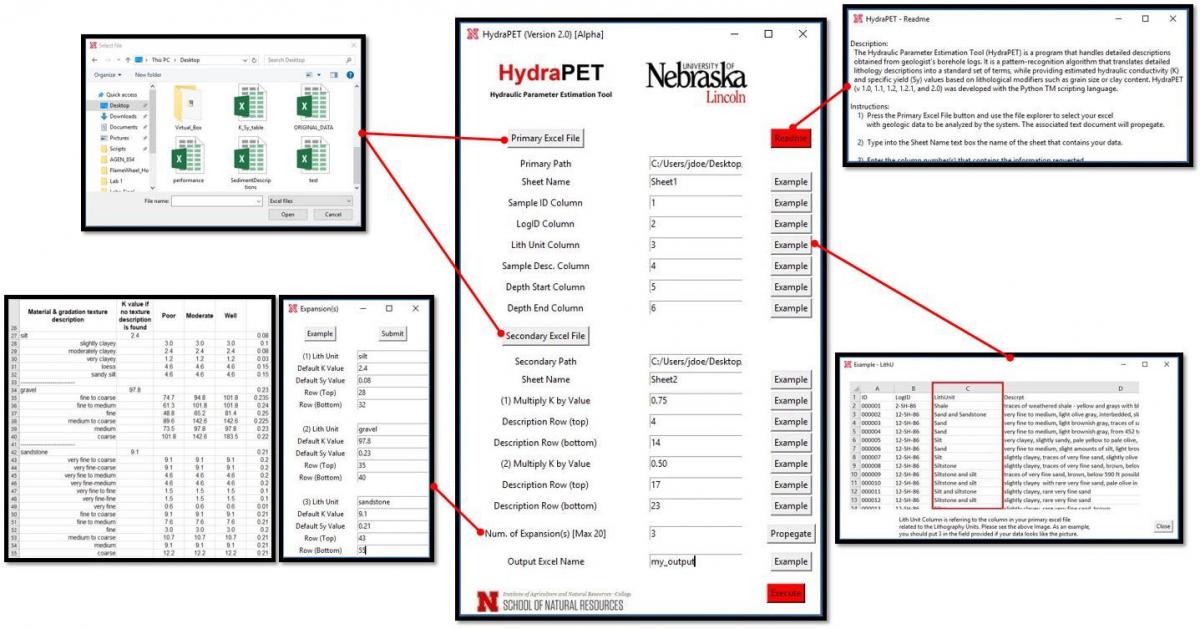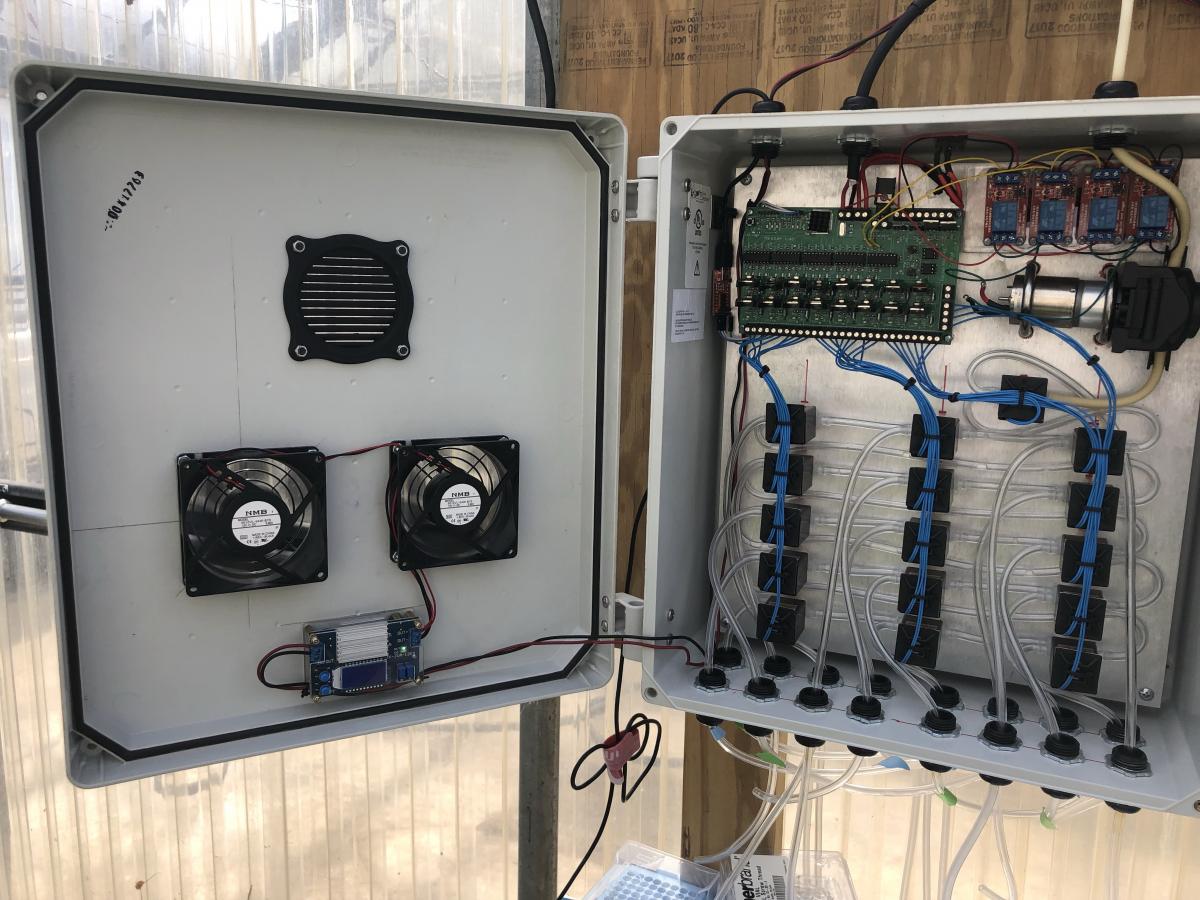HypeRpheno
HypeRpheno (download) is a graphical user interface created in MATLAB 2019b. It analyzes hyperspectral images (high-dimensional data) and performs spectral analysis, clustering analysis and classification analysis using custom algorithms. A dataset sample is included in HypeRpheno. Users of HypeRpheno should cite the following book chapter:
Gampa, S., & Quiñones, R. (2020). Data-driven techniques for plant phenotyping using hyperspectral imagery. In A. Samal & S. D. Choudhury (Eds.), Intelligent image analysis for plant phenotyping. Boca Raton, FL: CRC Press.
Product of: Rubi Quiñones, doctoral candidate in the School of Computing; Sruti Das Choudhury, assistant professor in the School of Natural Resources; and Ashok Samal, professor in the School of Computing.
CosegPP
This data repository available at Zenodo contains four datasets for plant phenotyping, with each dataset referencing:
- Two species physically different for challenging segmentation. (For example, a dataset might reference buckwheat, a thin plant with various leaf sizes, and sunflowers, a bushy plant with flowering.)
- The most commonly used induced environments in plant phenotyping, such as a control and drought-induced.
- A temporal resolution that begins with the plant's vegetative stage and ends with the plant fully matured.
- Modalities (infrared, visible, and near infrared) commonly used in plant phenotyping analysis.
- Multiple perspectives in plant phenotyping made available through three-dimensional analysis.
Product of: Rubi Quiñones, doctoral candidate in the School of Computing; Francisco Muñoz-Arriola, associate professor in the Department of Biological Systems Engineering; Sruti Das Choudhury, assistant professor in the School of Natural Resources; and Ashok Samal, professor in the School of Computing.
Tethered Aircraft-Unmanned System (TAUS)
The tethered aircraft-unmanned system (TAUS) is an unmanned platform prototyped for high-throughput environmental monitoring. TAUS has been field-tested and has recorded continuous flight times of more than six hours in remote locations using battery power. Tethered to a power source on the ground, TAUS is able to operate for extended periods of time and, thus, overcome the main limitation of existing unmanned aerial systems (UASs). The novelty of this system comes from leveraging the physical presence of the power tether by integrating sensors along it. With this feature, the system can acquire atmospheric data at multiple altitudes and produce a gradient.
Daniel Rico explains the system further in this TAUS video.
Product of: Daniel Rico, M.S. student in Computer Science Engineering, in collaboration with Carrick Detweiler, associate professor in the Department of Computer Science & Engineering, and Francisco Munoz-Arriola, associate professor in the Department of Biological Systems Engineering.
Education and communication products of the Council for Resilience Education
Eight NRT students and two other graduate students founded the Council for Resilience Education and registered it as an official student organization at the university in 2020. The council produces online articles, case studies, games, videos and podcasts to explain resilience theory and strategies for addressing environmental problems. Members of the council have developed a way to teach ecological resilience concepts using the game Jenga and have recorded instructions. They have also completed six education modules, Ecological Resilience, Alternative Stable State Theory and Regime Shifts, Scale, Heterogeneity, Adaptive Cycle and Panarchy, hosted online at the Plant & Soil Sciences eLibrary of the university. The elibrary serves as a free resource to teachers, students and anyone else seeking background on specific scientific topics. It receives about 11.5 million hits yearly and offers lessons and animations in English and Spanish.
The council has produced several episodes of the podcast "What the Heck is Resilience, Anyway?" These can be found on Soundcloud, Apple Podcasts, Spotify and Stitcher (see https://soundcloud.com/whra).
In 2022, seven NRT students and an NRT professor, Dirac Twidwell, published an Ecosphere article about the council's resources, "New multimedia resources for ecological resilience education in modern university classrooms."
Products of: Conor Barnes, Kate Bird, Katia Carranza, Dominic Cristiano, Hugh Ellerman, Dillon Fogarty, Julie Fowler, Katharine Hogan, Jessie Johnson, Alison Ludwig, Daniel Morales and Rubi Quiñones.

HydraPET
The Hydraulic Parameter Estimation Tool (HydraPET) is a program that handles detailed descriptions obtained from geologists’ borehole logs. It is a pattern-recognition algorithm that translates lithology descriptions into a standard set of terms while providing estimated hydraulic conductivity (K) and specific yield (Sy) values based on lithological modifiers such as grain size or clay content. HydraPET (v 1.0, 1.1, 1.2, 1.2.1, and 2.0) was developed in Python with a modular approach.
Product of: Daniel Rico, M.S. student in Computer Science Engineering, in collaboration with Jesse Korus, assistant professor in the School of Natural Resources, and Francisco Munoz-Arriola, assistant professor in the Department of Biological Systems Engineering.

The Multiplexer
The Multiplexer is both a hardware and software system intended for automatic water sampling from 16 separate mesocosms. Each mesocosm has a particular level of water contamination but with varying levels of natural means of contamination sequestration. When the system is coupled with a spectrometer, water quality analysis over time is possible. The software was developed in C, with a modular approach.
Product of: Daniel Rico, M.S. student in Computer Science Engineering, in collaboration with Tiffany Messer, assistant professor in the Department of Biological Systems Engineering.
PTDS
The Plant Trait Data Sifter is a software tool to assemble summaries of open-access data from plant trait databases. The program scrapes the back-end html code from a website containing an embedded table, cleans up the html until only the data remains and sorts through the cleaned data looking for particular plant species the user defined in the input files. Once entries in the table have been exhausted, the PTDS returns the matched lines of data and the performance of the search in regard to input misses in an Excel workbook for further user analysis. PTDS is programmed in Python using a modular approach. Versions 1.0 and 1.1 are in operation, and superseding variants are planned.
Product of: Daniel Rico, M.S. student in Computer Science Engineering, and Katharine Hogan, Ph.D. student in Natural Resources/Applied Ecology.


